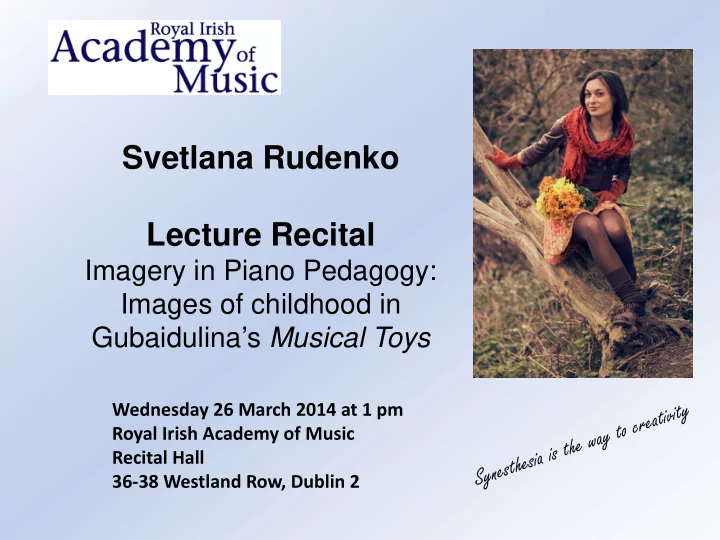

Svetlana Rudenko Lecture Recital Imagery in Piano Pedagogy: Images of childhood in Gubaidulina’s Musical Toys Wednesday 26 March 2014 at 1 pm Royal Irish Academy of Music Recital Hall 36-38 Westland Row, Dublin 2
Overview • Music Perception: cross modal processing • Gubaidulina • Cultivating a Synesthetical approach in the learning process, communication through Images.
Synesthetical Mind Secondary sensory (shapes, colours) Primary recognition (sound) • Synesthesia (ancient Greek [syn], ‘together’, and [aisthesis], ‘sensation’) is a neurological phenomenon in which stimulation of one sensory or cognitive pathway leads to automatic, involuntary experiences in a second sensory or cognitive pathway. • People Who Feel, Taste and Hear Color… • Are we all born as synesthetes…? Infants synesthesia.
Sofia Gubaidulina (24 Oct. 1931/ Chistopol, Tatar ASSR) Soviet Avant-Garde Composer Together with Schnittke, Denisov and Silvestrov she is now regarded worldwide as one of the leading representatives of New Music.
“ In the first instance, perhaps on a walk, I hear a huge, shapeless, multi-faceted sound, absolutely fascinating, with everything piled up together in a way you could never notate - something which exists outside time. It’s like a present, and I consider it a duty to transform it from vertical to horizontal ” Sofia Gubaidulina
Fish’s Night Song
Musical Toys (1969) “I often thought of my childhood and of the lack, in those days, of piano pieces that were able to take one back into the highly imaginative world of toys. At that time I also looked upon toys as material from which I could elicit sounds; they were part of the world of my musical sensations. With this collection, I have paid a late tribute to my childhood” S.G.
• Children’s cycle Musical Toys - synesthetical perception. • The texture of Gubaidulina’s pieces stimulates visual/auditory/tactile images in the imaginations of children.
1. Mechanical Accordion Images: 1. mf Mechanical Accordion 2. mp Voice / whistle
2. Magic Roundabout Images: 1. mp Magic Roundabout 2. f Spell
3. The Trumpet In The Forest Images: f Trumpet 1. p “Shadows” of the Forest 2.
4. The Magic Smith Images: 1. f Hammering of the Blacksmith 2. p Magic Spell 3. ff White Magic
5. April Day Images: Two-part Invention 1. Subject 2. Counterpoint
6. Song Of The Fisherman Images: 1. Song of the Fisherman 2. Water Reflections / ripples (perfect fifths)
8. A Bear Playing The Double Bass And The Black Woman Images: 1. A Bear Playing the Double Bass 2. Black Woman Humming 3. Piano Chords
9. The Woodpecker Images: 1. ‘Darkness’ of the Forest 2. Woodpecker 3. Small Bird
11. Sleigh With Little Bells Images: 1. Little Bells 2. “Road” / Sleigh 3. Song of the Bells
Conclusions • It could enhance musical imagination (and therefore learning) of a child if we find ways to stimulate the voluntary synesthetical senses as they will boost the involuntary senses. • “Synesthesia causes excess communication amongst brain maps…. Depending on where and how widely in the brain the trait was expressed, it could lead to both synaesthesia and to a propensity toward linking seemingly unrelated concepts and ideas - in short, creativity.” (Ramachandran and Hubbard, Journal of Consciousness Studies , 2001) • We can all refresh our synesthetical potential
13. The Drummer 14. Forest Musician
Recommend
More recommend